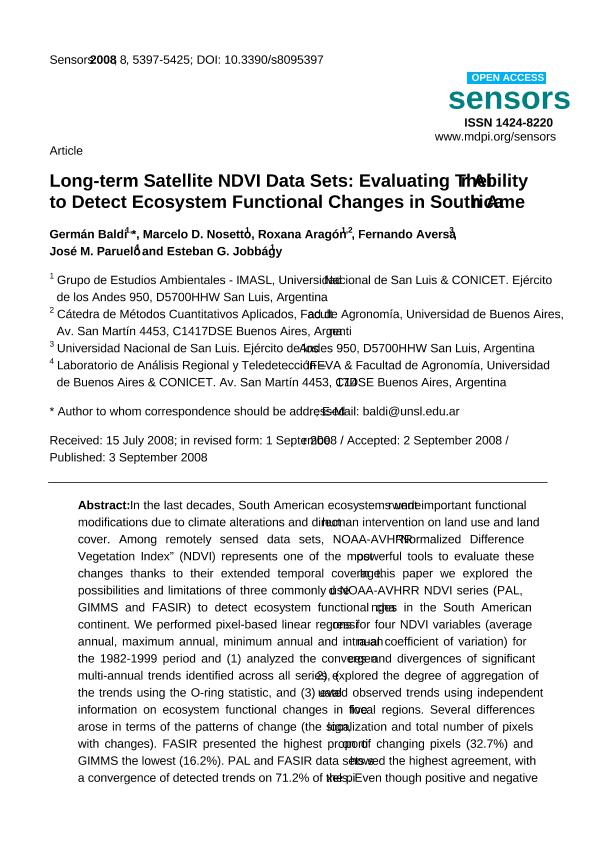Artículo
Long-term satellite NDVI data sets: evaluating their ability to detect ecosystem functional changes in South America
Baldi, Germán ; Nosetto, Marcelo Daniel
; Nosetto, Marcelo Daniel ; Aragón, Myriam Roxana
; Aragón, Myriam Roxana ; Aversa, Fernando; Paruelo, José
; Aversa, Fernando; Paruelo, José ; Jobbagy Gampel, Esteban Gabriel
; Jobbagy Gampel, Esteban Gabriel
 ; Nosetto, Marcelo Daniel
; Nosetto, Marcelo Daniel ; Aragón, Myriam Roxana
; Aragón, Myriam Roxana ; Aversa, Fernando; Paruelo, José
; Aversa, Fernando; Paruelo, José ; Jobbagy Gampel, Esteban Gabriel
; Jobbagy Gampel, Esteban Gabriel
Fecha de publicación:
09/2008
Editorial:
Molecular Diversity Preservation International
Revista:
Sensors
ISSN:
1424-8220
Idioma:
Inglés
Tipo de recurso:
Artículo publicado
Clasificación temática:
Resumen
In the last decades, South American ecosystems underwent important functional modifications due to climate alterations and direct human intervention on land use and land cover. Among remotely sensed data sets, NOAA-AVHRR "Normalized Difference Vegetation Index" (NDVI) represents one of the most powerful tools to evaluate these changes thanks to their extended temporal coverage. In this paper we explored the possibilities and limitations of three commonly used NOAA-AVHRR NDVI series (PAL, GIMIMS and FASIR) to detect ecosystem functional changes in the South American continent. We performed pixel-based linear regressions for four NDVI variables (average annual, maximum annual, minimum annual and intra-annual coefficient of variation) for the 1982-1999 period and (1) analyzed the convergences and divergences of significant multi-annual trends identified across all series, (2) explored the degree of aggregation of the trends using the O-ring statistic, and (3) evaluated observed trends using independent information on ecosystem functional changes in five focal regions. Several differences arose in terms of the patterns of change (the sign, localization and total number of pixels with changes). FASIR presented the highest proportion of changing pixels (32.7%) and GIMMS the lowest (16.2%). PAL and FASIR data sets showed the highest agreement, with a convergence of detected trends on 71.2% of the pixels. Even though positive and negative changes showed substantial spatial aggregation, important differences in the scale of aggregation emerged among the series, with GIMMS showing the smaller scale (11 pixels). The independent evaluations suggest higher accuracy in the detection of ecosystem changes among PAL and FASIR series than with GIMMS, as they detected trends that match expected shifts. In fact, this last series eliminated most of the long term patterns over the continent. For example, in the "Eastern Paraguay" and "Uruguay River margins" focal regions, the extensive changes due to land use and land cover change expansion were detected by PAL and FASIR, but completely ignored by GIMMS. Although the technical explanation of the differences remains unclear and needs further exploration, we found that the evaluation of this type of remote sensing tools should not only be focused at the level of assumptions (i.e. physical or mathematical aspects of image processing), but also at the level of results (i.e. contrasting observed patterns with independent proofs of change). We finally present the online collaborative initiative "Land ecosystem change utility for South America", which facilitates this type of evaluations and helps to identify the most important functional changes of the continent.
Palabras clave:
ECOSYSTEMS
,
FASIR
,
GIMMS
,
NDVI
,
NOAA-AVHRR
,
PAL
,
SOUTH AMERICA
,
TIME SERIES ANALYSIS
Archivos asociados
Licencia
Identificadores
Colecciones
Articulos(IFEVA)
Articulos de INST.D/INV.FISIOLOGICAS Y ECO.VINCULADAS A L/AGRIC
Articulos de INST.D/INV.FISIOLOGICAS Y ECO.VINCULADAS A L/AGRIC
Articulos(IMASL)
Articulos de INST. DE MATEMATICA APLICADA DE SAN LUIS
Articulos de INST. DE MATEMATICA APLICADA DE SAN LUIS
Citación
Baldi, Germán; Nosetto, Marcelo Daniel; Aragón, Myriam Roxana; Aversa, Fernando; Paruelo, José; et al.; Long-term satellite NDVI data sets: evaluating their ability to detect ecosystem functional changes in South America; Molecular Diversity Preservation International; Sensors; 8; 9; 9-2008; 5397-5425
Compartir
Altmétricas



